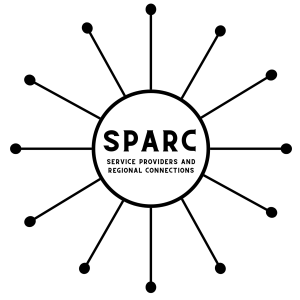
Across Coos and Curry Counties, we face a deeply interconnected crisis: a shortage of affordable housing, an aging and deteriorating housing stock, limited shelter options, and fragmented systems that too often fail to meet people where they are. For years, well-intentioned programs have worked in isolation—without the infrastructure to connect the dots.
That’s why we have partnered with our community to launch the SPARC Network—Service Providers and Regional Connections—a coordinated, regional initiative designed to unite shelter, housing, and supportive services under one collaborative framework. SPARC is more than a vision. It is a practical, actionable system for ending homelessness and building long-term stability—created specifically for rural Oregon.
What Is the SPARC Network?
The SPARC Network is a regionwide system of care that connects individuals and families to housing and supportive services at every step—from mobile outreach and emergency shelter to affordable rental units and homeownership opportunities. It’s built on the principle that no one should exit a shelter without a pathway forward.
What makes SPARC different is how it integrates services across the entire housing continuum:
- Shelter beds are tied directly to housing units
- Supportive services (like behavioral health and recovery) are embedded in housing
- Transitional and affordable rental housing are linked to options, including workforce and home ownership ownership models
SPARC is already in motion, with projects active or in development in Coos Bay, North Bend, Gold Beach, Powers, and Brookings. It’s a scalable model, rooted in collaboration and designed for the realities of rural communities.
Why Are We Involved?
The North Bend City / Coos-Curry Housing Authorities are proud founding partners in the SPARC Network. As Executive Director, I helped write the SPARC plan with the understanding that solving homelessness in our region requires system-building, not just service expansion.
Our Housing Authority played a vital role in launching Southern Oregon Coast Regional Housing (SOCRH) as a 501(c)(3) nonprofit. SOCRH now serves not only as the region’s Community Land Trust but also as the administrative backbone of the SPARC Network. Importantly, SOCRH is not a direct provider of shelter or services, and therefore does not compete with frontline organizations for funding. Instead, it supports the system as a whole—leveraging resources, aligning strategy, and providing critical infrastructure to strengthen all SPARC partners.
Who Are the SPARC Founding Partners?
SPARC was built collaboratively by local leaders in housing, shelter, health, education, and outreach. Founding partners include:
- Southern Oregon Coast Regional Housing (SOCRH) – Serves as the SPARC Network’s administrative backbone and leads the development of workforce housing and homeownership opportunities through a regional Community Land Trust.
- The Salvation Army – Coos Bay – Operates the Mobile Outreach Unit, a rural hub on wheels delivering pantry services, hygiene supplies, case management, and real-time connections to Coordinated Entry. The Mobile Unit serves as a front-door access point to the region’s housing system and partners with the Devereux Center to support shelter operations. TSA is also planning Hope Village, a transitional shelter village now in the pipeline.
- Alternative Youth Activities (AYA) – AYA is a holistic educational institution that now plays a leading role in helping entire families find stability. Through youth and family shelters, master-leased housing, and Rapid Rehousing, AYA is one of the region’s largest housing providers for families. Their integrated workforce development program equips both youth and parents with the tools to move from crisis to self-sufficiency.
- Devereux Center – A long-standing community anchor providing day shelter access, meals, mail, and case management. The Devereux Center supports site-based shelter programming while maintaining its critical role as a low-barrier hub for housing navigation for unsheltered individuals in Coos Bay.
- South Coast Health Equity Coalition – Ensures equity is embedded throughout the SPARC system by supporting trauma-informed practices, inclusive program design, and equitable access for historically underserved populations.
- Coos Health & Wellness – Provides behavioral health, addiction recovery, and supportive housing services embedded within SPARC sites and housing developments.
- Brookings CORE Response, SOVO, St. Timothy’s, ORCCA, – Expand access to shelter, peer-supported housing, outreach, and wraparound services across Coos and Curry Counties.
- Curry County Homeless Task Force – Serving as the Curry County SPARC Board and local planning body, helping drive system alignment and coordination in Curry communities.
We are currently working with additional partners to finalize MOUs and letters of support to join the founding body of SPARC.
Our Shared Vision
The SPARC Network was designed with one goal: to end homelessness by building the entire housing continuum. We are not interested in managing homelessness—we are building pathways to stability, healing, and homeownership.
This is the system we’ve always needed—and now we have the partners, projects, and infrastructure to bring it to life.
We will be bringing together the founding organizations in September for our first regional summit and planning session.
By Matthew Vorderstrasse, Executive Director
North Bend City / Coos-Curry Housing Authorities
